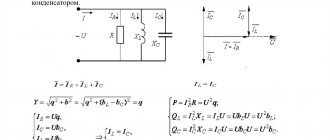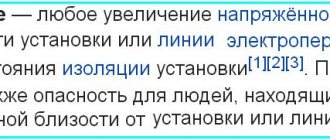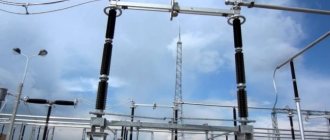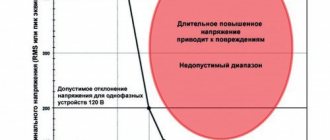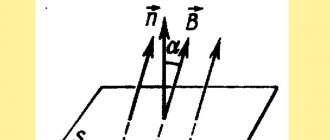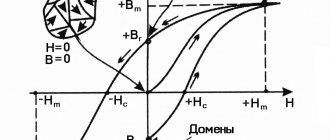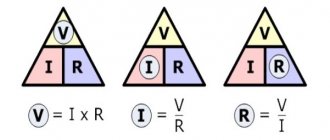Repair teams quite often encounter the problem of voltage in an open circuit. This phenomenon happens on overhead lines, often in household electrical networks. This is the so-called induced voltage that appears on disconnected wires due to the influence of the electromagnetic field from nearby power lines.
To better understand the effectiveness of protective measures during the repair of overhead power lines (OHT), let us consider in more detail the physical essence of pickup. This will help to better understand the mechanisms of protection against electric shock generated on disconnected wires.
What it is?
The term “induced voltage” hides the potential that arises in the zone of electromagnetic influence of existing electrical installations or electrical conductors.
Such interference can occur in the area of high-voltage lines, high-U electrical installations and even a household network. The phenomenon of induced voltage consists of 2 components, which we will consider in more detail.
Electrostatics
The creation of potential is explained by the propagation of an electric field from a source of electricity located in close proximity.
The greatest impact is typical for two wires that are located next to each other and are parallel to each other. In this case, one is under U, and the second is not.
The magnitude of the induced voltage depends on the following aspects:
- The size of the potential difference.
- The distance from a voltage power source to another element.
For better understanding, the system can be compared to one or more capacitors. Formally, the pickup is formed along the entire length of the conductor.
To avoid charge accumulation, it is necessary to ground the disconnected conductor. In this case, the induced voltage will go into the ground, and the work will be safe for humans.
To calculate static voltage, you need to multiply two elements:
- Capacitive influence coefficient. Its size can be obtained from the reference book, and the parameter itself depends on the distance to the source U and the type of conductor.
- Operating voltage.
The larger U is and the closer the conductor is, the higher the induced parameter.
To calculate the maximum induced voltage, the formula is used:
Electromagnetic component
There is another type of interference - EM induced voltage. Its essence is the spread of a magnetic field over a certain area in all directions from the conductor.
The stronger the EM field, the higher the induced U in the disconnected conductor.
The induced EMF in a disconnected power transmission line will be equal to:
When a conductor is grounded at the point of connection with the ground, the potential will be zero, but as it moves away from this place it will increase. This means that the maximum potential difference parameter will be at the most distant ends of the line (VL or CL).
The voltage at point x relative to the ground will be equal to:
Subscribe to the newsletter
Induced voltage is a physical phenomenon and occurs at high voltage levels.
It can arise both from the impact of constructed and operated electrical installations (overhead power lines and electrical substations), and as a result of natural thunderstorm phenomena, in which high-voltage electrical discharges are observed.
On overhead power lines (OHL), this impact is taken into account at an operating voltage of 220 kV and above. Let us consider the features of the appearance of induced voltage using the example of two overhead lines running parallel along the entire route.
Measurement of the induced line voltage is carried out by organizations operating overhead lines and in accordance with developed measurement techniques. Based on the measurement results, a List of overhead lines is developed that are under induced voltage after switching off. Further, in order to ensure the safety of personnel for work under induced voltage, technological maps (TC) and work execution projects (WPP) are developed as part of organizational measures. TC (PPR) determine the technology for performing work under induced voltage, excluding the possibility of electric shock to personnel from overhead line elements under induced voltage.
Requirements for the organization of work are regulated by the Rules for labor protection during the operation of electrical installations, approved by order of the Ministry of Labor of the Russian Federation dated June 24, 2013 No. 328n.
Examples of existing overhead lines that have mutual influence:
Source
What is the danger?
Induced voltage is no less dangerous than normal potential. If during a conductor short circuit the relay protection operates and cuts off the emergency section, in the case of an induced U, everything is more complicated. Here, protective devices will not work, so a person may find himself under prolonged exposure to negative factors.
During a short circuit on a working line, which is located near the disconnected section, on a de-energized overhead line, the induced voltage increases several times. As a result, repair personnel are exposed to the induced U, which can lead to burns and even cardiac arrest. The parameter value can reach 10-20 thousand Volts.
The PUE states that U above 25 V is already dangerous to human health. That is why it is important to carefully approach this circumstance and take measures to provide additional protection. How to protect yourself from wiring will be discussed later in the article.
Nature of the phenomenon
To understand the causes of the problems, you need to remember the basic concepts and terms from the school physics course. It is known that the passage of alternating current through a circuit provokes the formation of an electromagnetic field. Its force potential decreases in proportion to the square of the distance.
If a conductor is placed nearby, a current is induced in it. Without further explanation, the potential danger of electricity in a cable or other piece of equipment that is not connected to a power source is clear.
Reasons for appearance
When considering a tip-off, it is important to understand the reasons for its occurrence. For a better understanding, let's consider several situations - for an apartment, electrical wiring, electrical installations and overhead lines.
In the apartment
Interference in a regular 220 V network appears when the 0th conductor on the overhead line breaks or before entering the apartment (house). If you check the voltage using an indicator, the light will glow in any of the holes.
In fact, U is present only on one of the wires (phase), and the second one receives the induced potential. A phenomenon appears such as two phases in an outlet.
After the line is restored or zero is returned, the situation returns to normal.
When performing repair work in an apartment, it is necessary to turn off the input circuit breaker or remove the fuses to prevent voltage.
In electrical wiring
One of the signs of induced voltage is the glow of the housekeeper when the lights are off. In this case, the voltage can reach 40-60 V.
This situation arises when parallel laying of lines powering sockets and lighting devices in the apartment.
To fix the problem, you need to review the wiring routes and make sure that grounding or grounding is performed correctly.
But there is another reason. When creating wiring, 2 or 3 core wires are used. As a rule, cable products are placed in boxes, from where the conductors are directed to their consumers.
If the switch separates the neutral wire rather than the phase wire, an induced U appears. It has a small value, as noted above, but it is enough to ignite the diode lighting.
To solve the problem, you need to swap the phase and zero. This is not always possible, because one of the wires from the box goes directly to the light source and does not pass through the switch.
In electrical installations
Switches, power transformers, current and voltage transformers, as well as other electrical installations are inevitably connected to the power line. That is why they often come under induced voltage and most often this happens when the 0th conductor breaks.
Many electrical installations use insulated cables that contain tightly packed conductors.
Despite the short length of the sections, strong interference can occur with great risks for personnel. That is why, when performing such work, it is important to take protective measures, use PPE and follow the requirements of the PUE.
On the power line
We noted above that the electrostatic component of the pickup has an identical potential along the entire length of the conductor. To calculate the required value, the capacitive coupling coefficient is multiplied by the operating influencing voltage.
To ensure the protection of workers, one grounding at any point is sufficient.
Note that static U can arise not only in the presence of nearby EM fields, but also other factors - lightning or aurora.
Determination of induced voltage
The official terminology for induced voltage refers to the life-threatening potential that arises as a result of the electromagnetic effects of a parallel overhead line or electricity circulating in contact networks. This potential is parasitic, generated by the influence of a functioning parallel line of the electrical network and does not directly relate to the transported current. Hence the name - induced voltage.
What is the danger of the phenomenon?
The presence of potential in wires induced by alternating current or static electricity is often impossible to predict. This is the main danger of the tip-off. Standard protective devices do not respond to induced voltage. The electromechanic who has come under the influence of the interference will be subject to current until he, independently or with the help of a partner, releases his hand or other part of the body that came into contact with the exposed wire.
If, as a result of a short circuit on the overhead line, the protection is triggered, cutting off the operating voltage, the wires may be exposed to induced current. Danger also arises when lightning discharges appear, including those between clouds.
Please note: standard protection does not respond to response voltages resulting from interference. Therefore, when the overhead line is disconnected, special grounding schemes should be used that allow creating zero potential points in a specific zone when servicing the lines.
The danger is due to the behavior of the induced current. The fact is that the current source is interference from neighboring overhead lines, which does not spread equally along the entire length of the wire. Therefore, the behavior of such currents differs from the working electricity we are used to.
The presence of standard linear grounding does not guarantee safety, but, on the contrary, accompanies the appearance of electric current in disconnected wires. As can be seen in Figure 1, the maximum current is at the grounding points, that is, at the grounding blades.
Rice. 1. Voltage value between grounding blades
In some cases, it is advisable to disconnect the grounding of the overhead line, and for protection use portable grounding connections, which are installed on each side of the fault site, as close as possible to the point of work.
How to protect yourself, security measures
From the above it is clear that induced voltage carries great risks, which requires responsibility for implementing measures to protect people from falling into the danger zone.
Organizational security measures:
- Workers performing work in the wiring area must have the 3rd electrical safety group, and the work manager must have the 4th.
- Experience in repair and maintenance of power lines, as well as lightning protection elements.
- Organization of safety parameters near the workplace, implementation of activities specified in the application and work permit.
- The neutral wire in the group being measured is considered to be located under U.
- The beginning and completion of work is documented in writing. As a rule, an admission log is filled out with the signature of the employees, and an admission order is filled out.
Measurements and work cannot be carried out in conditions of heavy fog or wind, precipitation or poor visibility. If during the measurement process a worker identifies a damaged element of an overhead line or cable line, work is stopped until the problem is resolved.
When working on guided lines, the following nuances must be taken into account:
- Grounding must be within sight of the workplace.
- If there is only static voltage, one grounding is sufficient, but for reliability it is better to install a grounding electrode in two places. If one of the devices fails, the second one will back up.
- In the case of electromagnetic wiring, more serious safety measures are taken. In this case, grounding is installed directly at the workplace. In this case, the induced potential at the place where the work is performed will be zero.
Grounding is a reliable way to protect against induced voltage. But even in this case, the disconnected line will be negatively affected.
To work, you can choose one of the options:
- Disabling electrical installations that are parallel to the operating line. In this case, repair work must be carried out as quickly as possible to avoid downtime of consumers without electricity or a long-term decrease in network reliability.
- Dividing the line being repaired into several sections that do not have electrical connections. The principle mentioned above applies here. The point is that the amount of pickup directly depends on the length of the section.
- Work under voltage or with its disconnection, but with the use of special personal protective equipment. In this case, the employee’s actions are somewhat constrained, but it is possible to avoid disconnecting or reducing the reliability of the network.
To ensure personal safety, the following products are used:
- Voltage alarms - indicate the presence of U or interference.
- The use of protective clothing and dielectric-based mats to prevent the passage of current through the human body.
- Using voltage indicators, as well as electrically insulating rods to check the level of induced U.
- Work in boots and insulating gloves.
When using measuring devices and personal protective equipment, it is necessary to focus on class U for which they are intended.
Protection measures
Considering that induced currents can reach extremely dangerous values, especially in areas of overhead lines or in electrical installations, when servicing them, protective measures should be applied [2]:
Before carrying out work on pick-up lines, install portable grounding connections on both sides of the damaged section of the overhead line at a short distance. Ground wires from the surface of the ground using insulating rods. Maintain the operating distances of grounding protection.
Figure 5 shows how the distance from grounding affects the reduction of induced voltage.
Rice. 5. Reducing induced voltage
When measuring voltage, wear insulating gloves and boots, and place the measuring instruments on mats or stands. Use only measuring devices that are designed for the intended purpose and are rated to measure within the appropriate limits. Remember that standard protective devices are not designed for induced current. Measurements cannot be taken in conditions of fog, precipitation, or strong wind.
Always check for phase current on all wires. If using the UPSF-10 device you have determined the linear operating voltage, then using portable grounding is prohibited.
For safety reasons, always consider the neutral cable to be live.
Source
Results
The danger of induced voltage cannot be underestimated. In the absence of the necessary protection and the disconnected line is located in the zone of influence of a live conductor, interference can be life-threatening.
Awareness of possible risks, installation of grounding, following the rules of the Electrical Regulations and the use of PPE allows you to reduce the danger to a minimum.
These rules are mandatory for electrical installations, on cable lines and overhead lines, and must also be taken into account when performing work on a 220 V household network.

